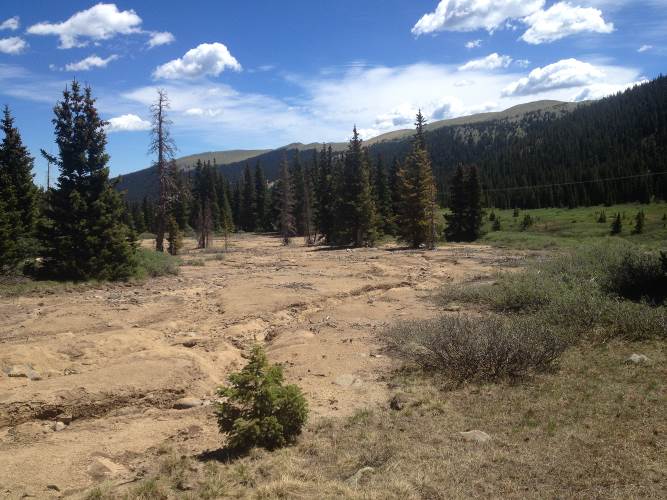Trout Unlimited (TU) is pleased to work with the National Forest Foundation (NFF) through their Matching Awards Program. This project will improve watershed health and reduce non-point source pollution by removing contaminated sediment and establishing native vegetation. TU would also like to take this opportunity to thank Freeport-McMoRan and the U.S. Forest Service for their private and federal cash contributions to the project. Their technical guidance and financial commitments have made this project a reality.
The Leavenworth Creek Restoration Project (LCRP) is approximately six miles southwest of Georgetown, Colorado. The majority of the Leavenworth Creek watershed is within the Arapaho & Roosevelt National Forests and Pawnee National Grasslands. Leavenworth Creek is a tributary of South Clear Creek, which is the drinking water source for Georgetown via an intake approximately one mile above the confluence with Clear Creek.


Both photos were taken looking downslope towards Leavenworth Creek. Notice several braided channels that are currently transporting dispersed tailings and sediment into Leavenworth Creek. These fine grained tailings are highly erosive with little to no vegetation.
Historically, the headwaters region of Leavenworth Creek was also known as the Argentine Mining District where mining began in the late 1860s and continued until the 1950s at the Waldorf, Vidler, and Santiago mines. During mining activities a large area of dispersed mill tailings was created via slurry channels stemming from the Waldorf mill. The mill tailings were dispersed down valley and continue to leach high levels of metals and sediment into Leavenworth Creek. A highly braided channel network exists within this dispersed tailings area, which begins downslope and east of the Waldorf tailings piles, and continues until a confluence with Leavenworth Creek.
This project will focus on constructing a single thread 2,210 ft. riprap lined channel, and removing 5,400 cubic yards of dispersed tailings. Tailings will be excavated from the channel path and buried in on-site repositories that will also act as riprap sources for the channel material. Stored tailings will be covered with one foot of clean soil, compacted, and seeded. The single thread channel will utilize several large boulders and woody debris in the channel to provide roughness and reduce flow in steeper sections of the channel. A ten foot vegetated floodplain bench will be created on both sides of the channel and seeded with a native high elevation seed mix. This buffer zone will act as a floodplain to slow down high flows associated with spring runoff and summer rainfall events. RMC Consultants has been recently selected as the contractor with work scheduled to begin in early August.

